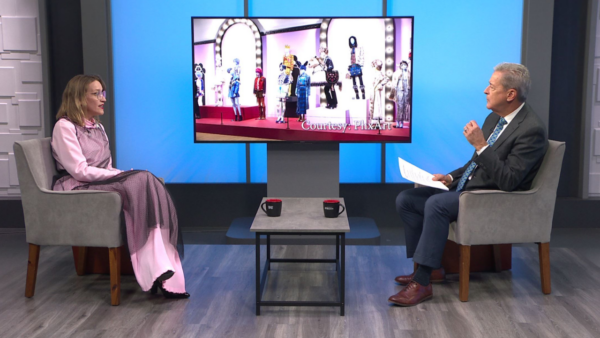An Arizona State University scientist and a colleague have developed a first-of-its-kind equation to estimate the monetary value of natural resources such as fish stock, groundwater or forests. The formula can be used to create markets for natural resources, helping to encourage sustainable practices. Josh Abbott, an associate professor in ASU’s School of Sustainability, will discuss his report.
Ted Simons: Tonight's focus on sustainability looks at an attempt to develop a first of its kind method to estimate the monetary value of natural resources. The idea is to create markets that would encourage sustainable practices. Here now is Josh Abbott, an associate professor at ASU's school of sustainability. And you are kind of the guy behind this whole thing, aren't you?
Josh Abbott: Yes, I am, along with the elected official.
Ted Simons: We're measuring the monetary value of natural resources. Explain, please.
Josh Abbott: So, when I talked, when we say the monetary value of natural resources, we're not thinking about the value of using them, so, you know, if you wanted to find the value of a fish and, and use, you could go to the supermarket, right and find the price of a filet of cod or something. What we're looking at is the value of the resources in preservation, the value of a fish in the water, the value of groundwater in the aquifer, so this is the value of the, the sort of streams of benefits that, that, that natural capital, if you will, could provide to, to us and to future generations.
Ted Simons: Which would lead to what, asset markets for, for natural capital? Is that what we're talking about here?
Josh Abbott: It could lead to asset markets, but, one of the fundamental differences between natural capital and, and the other kinds of capital that we often think about in society, like your house, or, or a stock, is, is that, that, that most natural capital does not have a market. AND so, what we're trying to do with this research is to step in when there is not a market, not a natural price, so, like, you know, you know that there is a price for, for the house, and you can go on zillow and find that, or, you know, some other resource and, and go to the Dow Jones Industrial Average and look at the stock price, and there is not that sort of resource for capital, so what we're trying to do, is, is to sort of step in and provide a price that is, that is like, like the prices that we see for other kinds of assets, and so that we can put natural capital on even par and other forms of capital.
Ted Simons: So, define, define natural resource, I have got the fish in there, and what else is included?
Josh Abbott: So, this, this really includes any sort of feature of, of the, of an eco-system, the natural world around us that, that has this long lived property, not just provides benefits today, but, also, can provide benefits for tomorrow. So, this could include all kinds of renewable resources like groundwater are renewable and this could include, you know, the fish example that I gave, could include the forest but also could include the atmosphere, and so the amount of carbon that is out there in the atmosphere is, actually, sort of not an asset, but also, a liability, but it's still a capital asset in a way, right.
Ted Simons: And indeed, but, how do you measure the monetary value or the, the capital, how do you measure the value of this stuff? It sounds like, there is -- you have changing metrics, ecology and human behavior and moving goalposts all over the place.
Josh Abbott: And no one said it was easy, and the, the basic idea is to take principles that are there for asset pricing that are well-known and recognized to anyone in finance and, and to, to modify them a bit, to, to account for the unique properties of natural capital, so, usually when we think about a, a financial asset, we would think about the value of being a function of the dividends that we expect it to pay out over time, or the capital gains it might have over time and, and we would, you know, discount that back in some way, and that would be the way that we would think about it. Here, with natural capital, we have to think about an added dimension, which is that, if it's a renewable resource, it, actually, can physically grow, if we leave it in place. So, we can, actually, we actually need to account for the ecology, the sort of rate of growth, and it's like nature is giving us a rate of interest on top of, of the usual rate of interest, so we built that into the formula, and we also have to think about how the resources are managed through time. The kinds of management that are applied. So, is, is, in the case of the fishery, is it well managed or poorly managed, and that's going to influence the trajectory of the value of capital over time.
Ted Simons: And this value of the capital, is it different for you than it might be for me than it might be for them? And, and a factor, factor that into an equation that seems, seems like it's moving a bit there.
Josh Abbott: Right, so, definitely in society, we have different values. Now, the idea here in this formula is that we would sort of bring the different values together into, into the evaluation. And people might all value a different stock, differently, too, but the fact is that there remains a price for that stock, the market agrees on, so we are trying to resolve all those sort of different evaluations here in a similar way through the pricing, but there are different values held by different members of society.
Ted Simons: It would be very interesting to see who values and how much. Implications for policy-makers, and implications for stakeholders, what are you seeing?
Josh Abbott: So I think that there is two levels of, of applications. One is that, that, for a very particular asset, so for a particular aquifer or, or for a particular fishery, we can, basically, do a cost benefit analysis of what's the value of, of, you know, using the resource now, and withdrawing the water now, versus keeping it in the ground, so preservation versus conservation, and so our, our metric, our, our equation is providing that conservation value, and this would be the same in a fishery, the context, as well and, and the other sort of context where we might use, use the values is to, is to develop indicators for sustainability, so, sort of big scale indicators that are called Green accounting measures. And, and where we try to sort of get a sense, or, or from one generation to the next, are we, we enhancing the value of the natural resources or making them go down? And, and in order to do that, you have to have values on them. So, we can supply the values that would go into that sort of accounting exercise to sort of let us know, are we more sustainable than the previous generation or less?
Ted Simons: Last question, what is next for this idea?
Josh Abbott: Yeah, so we're looking at a few different Avenues and, and we want to, to extend the application in this paper, which was to one particular fish stock in the Gulf of Mexico to valuing fish stocks in a variety of different places, and particularly, and try to fill out all the values for, for the, the U.S. fish stocks, and then we're also looking at applications, specifically, in groundwater and forestry. And, and looking to, to, to sort of broaden the base of, you know, of the types of capital that we have applied this formula to.
Ted Simons: So basically, emerging markets for stuff that's been there for a long time?
Josh Abbott: Right, and trying to acknowledge the value of it.
Josh Abbott: Very good. Very interesting. Good to have you here, thanks for joining us.
Ted Simons: Thank you.
Josh Abbott:Associate Professor, School of Sustainability at Arizona State University;























